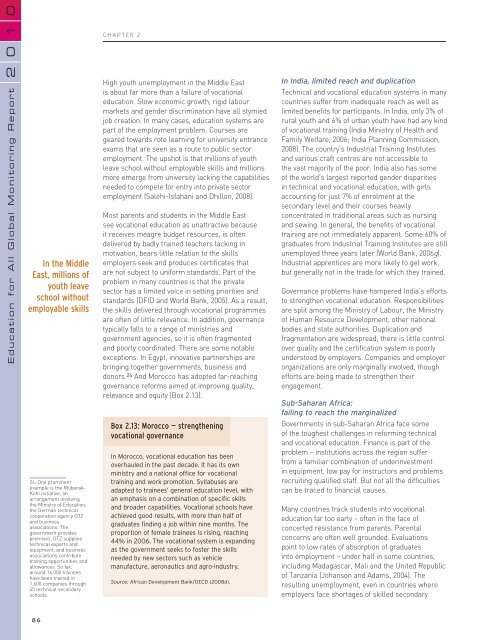Chapter 2. Progress towards the EFA goals - Unesco
Chapter 2. Progress towards the EFA goals - Unesco
Chapter 2. Progress towards the EFA goals - Unesco
You also want an ePaper? Increase the reach of your titles
YUMPU automatically turns print PDFs into web optimized ePapers that Google loves.
0<br />
1<br />
0<br />
CHAPTER 2<br />
2<br />
Education for All Global Monitoring Report<br />
In <strong>the</strong> Middle<br />
East, millions of<br />
youth leave<br />
school without<br />
employable skills<br />
24. One prominent<br />
example is <strong>the</strong> Mubarak-<br />
Kohl initiative, an<br />
arrangement involving<br />
<strong>the</strong> Ministry of Education,<br />
<strong>the</strong> German technical<br />
cooperation agency GTZ<br />
and business<br />
associations. The<br />
government provides<br />
premises, GTZ supplies<br />
technical experts and<br />
equipment, and business<br />
associations contribute<br />
training opportunities and<br />
allowances. So far,<br />
around 16,000 trainees<br />
have been trained in<br />
1,600 companies through<br />
45 technical secondary<br />
schools.<br />
High youth unemployment in <strong>the</strong> Middle East<br />
is about far more than a failure of vocational<br />
education. Slow economic growth, rigid labour<br />
markets and gender discrimination have all stymied<br />
job creation. In many cases, education systems are<br />
part of <strong>the</strong> employment problem. Courses are<br />
geared <strong>towards</strong> rote learning for university entrance<br />
exams that are seen as a route to public sector<br />
employment. The upshot is that millions of youth<br />
leave school without employable skills and millions<br />
more emerge from university lacking <strong>the</strong> capabilities<br />
needed to compete for entry into private sector<br />
employment (Salehi-Isfahani and Dhillon, 2008).<br />
Most parents and students in <strong>the</strong> Middle East<br />
see vocational education as unattractive because<br />
it receives meagre budget resources, is often<br />
delivered by badly trained teachers lacking in<br />
motivation, bears little relation to <strong>the</strong> skills<br />
employers seek and produces certificates that<br />
are not subject to uniform standards. Part of <strong>the</strong><br />
problem in many countries is that <strong>the</strong> private<br />
sector has a limited voice in setting priorities and<br />
standards (DFID and World Bank, 2005). As a result,<br />
<strong>the</strong> skills delivered through vocational programmes<br />
are often of little relevance. In addition, governance<br />
typically falls to a range of ministries and<br />
government agencies, so it is often fragmented<br />
and poorly coordinated. There are some notable<br />
exceptions. In Egypt, innovative partnerships are<br />
bringing toge<strong>the</strong>r governments, business and<br />
donors. 24 And Morocco has adopted far-reaching<br />
governance reforms aimed at improving quality,<br />
relevance and equity (Box <strong>2.</strong>13).<br />
Box <strong>2.</strong>13: Morocco — streng<strong>the</strong>ning<br />
vocational governance<br />
In Morocco, vocational education has been<br />
overhauled in <strong>the</strong> past decade. It has its own<br />
ministry and a national office for vocational<br />
training and work promotion. Syllabuses are<br />
adapted to trainees’ general education level, with<br />
an emphasis on a combination of specific skills<br />
and broader capabilities. Vocational schools have<br />
achieved good results, with more than half of<br />
graduates finding a job within nine months. The<br />
proportion of female trainees is rising, reaching<br />
44% in 2006. The vocational system is expanding<br />
as <strong>the</strong> government seeks to foster <strong>the</strong> skills<br />
needed by new sectors such as vehicle<br />
manufacture, aeronautics and agro-industry.<br />
Source: African Development Bank/OECD (2008d).<br />
In India, limited reach and duplication<br />
Technical and vocational education systems in many<br />
countries suffer from inadequate reach as well as<br />
limited benefits for participants. In India, only 3% of<br />
rural youth and 6% of urban youth have had any kind<br />
of vocational training (India Ministry of Health and<br />
Family Welfare, 2006; India Planning Commission,<br />
2008). The country’s Industrial Training Institutes<br />
and various craft centres are not accessible to<br />
<strong>the</strong> vast majority of <strong>the</strong> poor. India also has some<br />
of <strong>the</strong> world’s largest reported gender disparities<br />
in technical and vocational education, with girls<br />
accounting for just 7% of enrolment at <strong>the</strong><br />
secondary level and <strong>the</strong>ir courses heavily<br />
concentrated in traditional areas such as nursing<br />
and sewing. In general, <strong>the</strong> benefits of vocational<br />
training are not immediately apparent. Some 60% of<br />
graduates from Industrial Training Institutes are still<br />
unemployed three years later (World Bank, 2006g).<br />
Industrial apprentices are more likely to get work,<br />
but generally not in <strong>the</strong> trade for which <strong>the</strong>y trained.<br />
Governance problems have hampered India’s efforts<br />
to streng<strong>the</strong>n vocational education. Responsibilities<br />
are split among <strong>the</strong> Ministry of Labour, <strong>the</strong> Ministry<br />
of Human Resource Development, o<strong>the</strong>r national<br />
bodies and state authorities. Duplication and<br />
fragmentation are widespread, <strong>the</strong>re is little control<br />
over quality and <strong>the</strong> certification system is poorly<br />
understood by employers. Companies and employer<br />
organizations are only marginally involved, though<br />
efforts are being made to streng<strong>the</strong>n <strong>the</strong>ir<br />
engagement.<br />
Sub-Saharan Africa:<br />
failing to reach <strong>the</strong> marginalized<br />
Governments in sub-Saharan Africa face some<br />
of <strong>the</strong> toughest challenges in reforming technical<br />
and vocational education. Finance is part of <strong>the</strong><br />
problem – institutions across <strong>the</strong> region suffer<br />
from a familiar combination of underinvestment<br />
in equipment, low pay for instructors and problems<br />
recruiting qualified staff. But not all <strong>the</strong> difficulties<br />
can be traced to financial causes.<br />
Many countries track students into vocational<br />
education far too early – often in <strong>the</strong> face of<br />
concerted resistance from parents. Parental<br />
concerns are often well grounded. Evaluations<br />
point to low rates of absorption of graduates<br />
into employment – under half in some countries,<br />
including Madagascar, Mali and <strong>the</strong> United Republic<br />
of Tanzania (Johanson and Adams, 2004). The<br />
resulting unemployment, even in countries where<br />
employers face shortages of skilled secondary<br />
86
















